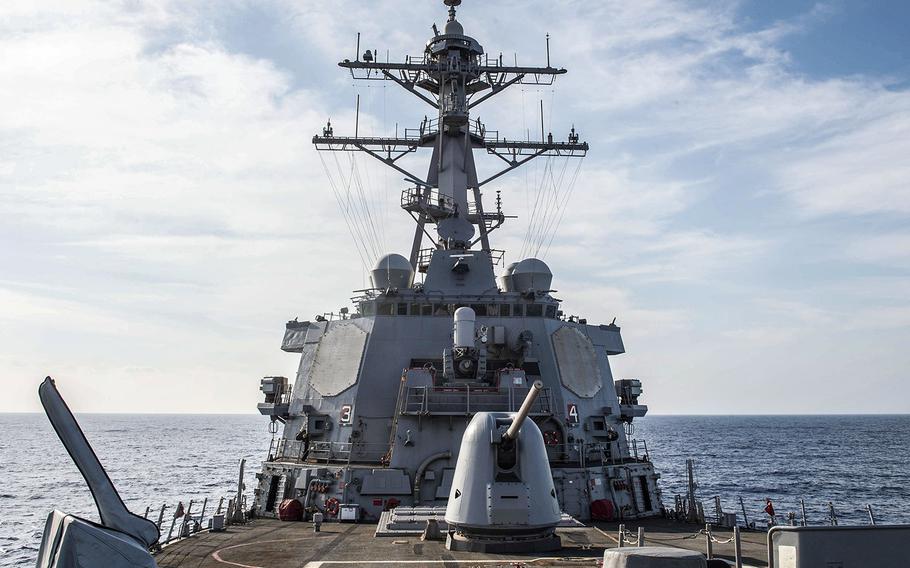
The guided-missile destroyer USS Arleigh Burke (DDG 51) transits the Mediterranean Sea on Oct. 7, 2018. (Justin Yarborough/U.S. Navy)
The U.S. Navy will request funding for eight new vessels in the next fiscal year budget, down from the 12 originally sought in a Trump administration blueprint meant to build a vastly larger fleet of ships and submarines, according to budget data and officials.
The Biden administration's $715 billion Pentagon budget for the year starting Oct. 1 will call for funding to build four combat vessels and four support ships. That includes two Virginia-class submarines, one DDG-51 Aegis destroyer and one Constellation-class frigate, according to three U.S. officials familiar with the request.
Other vessels sought include a John Lewis-class refueler, two Navajo-class T-ATS salvage and towing vessels and one Auxiliary Ocean Surveillance Vessel, said the officials, who asked not to be identified because the details aren't yet public.
The shipbuilding target will be included in the Biden administration's fiscal year 2022 budget request, expected to be out May 27. It shows a decrease from the Trump administration's goal, outlined in a "Fiscal Planning Framework" document last year, that aimed for a potential fleet of some 500 vessels, manned and unmanned, by 2045.
The Trump plan called for two of the Aegis destroyers — not just the one in the new Biden plan — and two Expeditionary Fast Transport vessels, among the potential 12.
Navy officials didn't immediately respond to questions about the budget request.
The new request signals a step back from the Trump framework, which called for 403 battle force ships, up from about 296 manned ships today, and 143 unmanned vessels by 2045. The director of the Office of Management and Budget at the time, Russell Vought, had called the Trump plan "a credible, affordable road map for achieving maritime supremacy — all while tightening our belts — and sending a strong message to our adversaries like China."
Not everyone agreed. Many observers saw the plan as a costly effort to paint the Biden administration into a corner on the assumption it would draw bipartisan support from lawmakers representing shipbuilding states, such as Rhode Island, Connecticut, Alabama, Virginia and Mississippi.
Instead, the fiscal 2022 request will likely be seen as a status quo or placeholder budget as the Biden administration completes its Global Force Posture Review and an updated China strategy. It could also draw bipartisan criticism from lawmakers who will question what message the request sends to China about the Pentagon's commitment to strengthening its fleet.
For context, the Navy requested eight new vessels for the current fiscal year. Its original plan was to request seven in fiscal 2022, so the Biden blueprint increases that by one; the Navy requested 12 new ships in fiscal 2020 and 10 in fiscal 2019.
The Navy request may be the dollars-and-cents reflection of a reality voiced by some lawmakers and Navy leaders that amid trillions in coronavirus pandemic spending, there's little new money available to buy many new vessels as the service is hard pressed to maintain the ones in inventory.
For example, House and Senate defense lawmakers crafting this year's defense policy bill wrote that the Navy's new frigate program faces "significant risks" amid a surge in cost estimates. Lawmakers cited the need for "cost realism" in the new frigate program.
Admiral Michael Gilday, the chief of naval operations, told House defense appropriations subcommittee members last month that "we know through our analysis that based on our current outline, we can sustain a Navy of about 300 to 305 ships." The costs involve "not just the hulls — it's the people, it's to fill the magazines with munitions, it's to train the people — it's all of those things that give you a whole fleet that can fight," Gilday said.
The most notable issue in the upcoming request is the elimination of one Arleigh Burke DDG-51 destroyer built by the General Dynamics Corp.'s Bath Iron Works unit in Bath, Maine. The DDG-51s in recent years had been bought at a rate of two to three ships per year. The Navy's fiscal 2021 five-year plan showed a rate of two per year for the first two years, then reduced it to a total of four in the final three years.
A request for one DDG-51, rather than the two originally projected for fiscal 2022, "could become a matter of focus, particularly for supporters" of Navy shipbuilding, said Ron O'Rourke, the top Navy analyst for the non-partisan Congressional Research Service.
The reduction may also be questioned in "a context of the Navy wanting to shift to a more-distributed fleet architecture," he said. That means putting more of the Navy's capabilities on a larger number of ships, especially small and medium-sized vessels, tied together with satellite-based networks to share warning and targeting data.